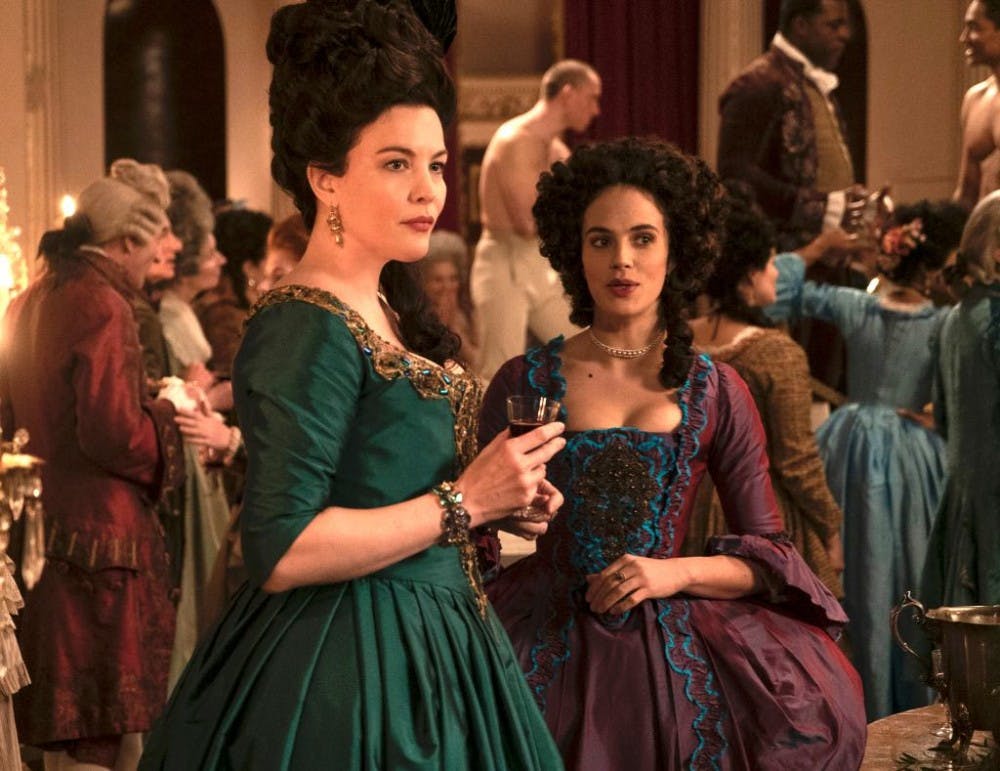First there’s the sound of drums, followed by the surprising rip of an electric guitar. Then flashes of a woman in a blue dress, a loose ribbon twirling around her ankles. Bold white text interrupts her journey through a crowded street, proclaiming that it is 1763, “London is booming,” and “one in five women makes a living selling sex.”
Harlots makes sure to grab the audience’s attention from the very first scene. We quickly find out that the woman in the blue dress is the young Lucy Wells, the daughter of Madam Margaret Wells, who oversees a bustling brothel in Soho. She has an older sister named Charlotte, who, according to one enamored patron, has eyes that “dart delight” and a bosom that “enchants to rapture.” The show begins by following the three women, all of whom are involved in prostitution, as they navigate the lucrative yet illegal trade.
A drama through and through, Harlots features sex, betrayal, murder, and multiple high–stake (and at times confusing) storylines. But unlike many dramas that suffer from flat characters and predictable twists, Harlots goes above and beyond in crafting stories people care about, especially for the period. When most of us think of 18th–century England, we think of the books we had to read in high school—stories primarily focused on the love lives of white, upper–class men and women. Those books are classics for a reason, but diversity wasn’t their strong suit.
Harlots breaks through the mold by featuring a cast of primarily poor, brown, and LGBT men and women in various roles of power, fighting for a place in a world that wants to forget they exist. A harlot falls in love with a Bible–thumping, fundamentalist woman. A former slave must use her exoticism to become a successful prostitute and eventual brothel–owner. Season three, which premiered July 10, introduces the characters to a “molly house,” a brothel for gay male prostitutes, during a time when homosexual acts were punishable by hanging. Though everyone in the show has an important story to tell, it’s the women who are front and center, with complex social and sexual lives that at times exist entirely outside of men.
As salacious as Harlots is, much of it is also based in truth. According to one historian, as many as 50,000 women sold sex in London at the time, so the lives of the Wells women mirrored the actual lives of many in Georgian England. Smaller details in the show are also shockingly accurate. In the first episode, the women read from a booklet that reviews the “wares” of local harlots in great detail, much like the 18th-century version of Yelp, but for prostitutes. This book was, in fact, real and had a circulation of thousands.
The history is interesting, but what makes Harlots an absolute showstopper is how it handles moral conflicts. A drama focused on sex has the potential to be pretty shallow, but Harlots isn’t afraid of tackling complex themes that force viewers to question what they believe. The show asks its audience if it’s possible for characters to find liberation in a system that is at its core exploitative of women. At the time, prostitution was arguably the only way for young, poor girls to become financially and socially independent. As Charlotte points out in episode one of season three, women turn to her brothel because it provides “income and safety,” both of which are in short supply.
But at the same time, harlots are inextricably tied to their male customers, who have the money, reputation, and legal connections to effectively ruin their lives. Charlotte and Lucy must deal with the ramifications of their own mother raising them to survive in such a dangerous, demeaning profession. Is their freedom worth it?

